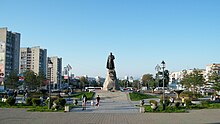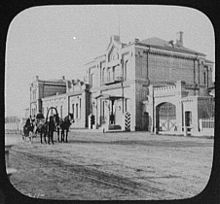-
하바롭스크 여행기1->아무르강 유람선->영원의 불꽃->프레오브라젠스킨 성당->호텔->하바롭스크 공항->인천공항나의 여행기 2020. 2. 3. 15:48
하바롭스크 여행기1
아무르강 유람선->영원의 불꽃->프레오브 라젠스키 성당->호텔->하바롭스크 공항->인천공할
콤소물광장에서 버스를 탔다.
중식을 해결하기 위해
한글이 보인다.
화성 뱃놀이 축제
화성시를 다니던 버스
중고로 팔려왔나보다.
다시 칠하자니 돈 들고
돈 아끼고
외제 임을 알리는 좋은 본보기가 아닌가?
골든 타임 호텔에서 중식
골든 타임 호텔
Квартира в центре города на Слободской 2
The apartment offers a children's playground.
The nearest airport is Khabarovsk Novy, 14 km from Квартира в центре города на Слободской 25, and the property offers a paid airport shuttle service.
This is our guests' favourite part of Khabarovsk, according to independent reviews.
Distance in property description is calculated using © OpenStreetMap
5분만에 식사 장소로
그저 그런 식사다.
베르바 호텔로 향했다.
30여분만에
VERBA호텔에
VERBA 홈페이지
베르바호텔은 손님들 과 하바롭스크시민들이 쾌적한 휴식을 즐길수 있는 현대적인 호텔입니다. 호텔에서는 매우 친절한 직원, 편안한 시설설비, 고급스러운 서비스를 제공하며 고객이 최우선인 친절 과 깔끔한 환경이 베르바 호텔의 장점입니다.
베르바호텔 근처에 있는 문화휴식공원, 아무르강변, 향토박물관, 예술박물관, 아동청년극장, 쇼핑몰 과 오락기관들을 각자의 취향대로 고를수 있습니다. 저희 호텔은 손님들에게 무료 와이파이 서비스, 무료 국제전화서비스 와 시외전화서비스를 제공하며 스파, 레스토랑을 즐길수있으며 한시간 무료 주차권리가 적용됩니다. 전 객실은 에어컨 및 히터 컨트롤 시스템, 위성 채널을 시청할수 있는 LCD TV, 미니바, 개인 금고를 갖추고 있습니다. 각 객실은 실내 욕실을 갖추고 있고 욕실에는 목욕 가문과 실내용 슬리퍼, 욕실 액세서리, 헤어 드라이어가 구비되어 있습니다. 베르바호텔은 반려동물동반가능한 호텔입니다.
호텔밖 풍경
전부 LG에어콘이다.
02시 20분 아무르강 선착장으로 갔다.
시간이 남아 공원을 이리저리
우리가 탈 유람선
15:30분 출발이다.
N.N. Zadornov 자가(풍자문학)
이는 또 누군가?
동상이 참 많다.
Khabarovsk Bridge
Khabarovsk Bridge is a road and rail bridge built in 1999. It crosses the Amur River in eastern Russia, and connects the urban-type settlement of Imeni Telmana in the Jewish Autonomous Oblast with the city of Khabarovsk in Khabarovsk Krai. Until that time an older bridge built in 1916 existed nearby.
https://en.wikipedia.org/wiki/Khabarovsk_Bridge
아무르강 유람선
구원 회귀 성당
프레오브 라젠스키 성당
The Transfiguration Cathedral (Russian: Спасо-Преображенский собор, Spaso-Preobazhensky sobor) on a steep bluff overlooking the Amur River in Khabarovsk stands 96 meters tall and is supposed to be the third tallest church in Russia after St. Isaac's Cathedral and the Cathedral of Christ the Saviour. It was built over 2001-2004 to a traditional design reminiscent of Konstantin Thon's works. The church is surmounted by four Ukrainian-style gilded domes, the central one being the largest. Its spectacular location on a hill was chosen by Patriarch of Moscow and all Rus' Alexis II of Moscow during a helicopter flight over Khabarovsk.
https://en.wikipedia.org/wiki/Transfiguration_Cathedral,_KhabarovskСпасо-Преображенский собор
4일차
06:20
공항으로 출발했다.
왕복 4차선 도로이지만
차선이 있는 듯 없는 듯
노란선은 없다.
공항가는 큰 길이지만 차는 별로 없다.
호텔에서 25분 만에 하바롭스크 국제공항에 도착했다.
공항대합실
작은 면세점 하나 있는
붐비지 않는 작은 공항이다.
오로라 항공기는 08:21분 이륙했다.
아무르 강이 내려다 보이는 하바롭스크 상공을 지난다.
기내식 중 왼쪽
제일 좋다. 나에게는
Khabarovsk
Khabarovsk (Russian: Хаба́ровск, tr. Khabarovsk, IPA: [xɐˈbarəfsk] (
 listen)) is the largest city and the administrative center of Khabarovsk Krai, Russia, located 30 kilometers (19 mi) from the Chinese border, at the confluence of the Amur and Ussuri Rivers, about 800 kilometers (500 mi) north of Vladivostok. The city was the administrative center of the Far Eastern Federal District of Russia from 2002 until December 2018, when Vladivostok took over that role. It is the largest city in the Russian Far East, having overtaken Vladivostok in 2015. As of the 2010 Census, its population was 577,441. It was previously known as Khabarovka (until 1893). Khabarovsk is the closest major city to Birobidzhan, which is a town and the administrative center of the Jewish Autonomous Oblast.
listen)) is the largest city and the administrative center of Khabarovsk Krai, Russia, located 30 kilometers (19 mi) from the Chinese border, at the confluence of the Amur and Ussuri Rivers, about 800 kilometers (500 mi) north of Vladivostok. The city was the administrative center of the Far Eastern Federal District of Russia from 2002 until December 2018, when Vladivostok took over that role. It is the largest city in the Russian Far East, having overtaken Vladivostok in 2015. As of the 2010 Census, its population was 577,441. It was previously known as Khabarovka (until 1893). Khabarovsk is the closest major city to Birobidzhan, which is a town and the administrative center of the Jewish Autonomous Oblast. History
17th-century Russian explorers
In the mid-17th century, the Amur Valley became the scene of hostilities between the Russian Cossacks, trying to expand into the region and to collect tribute from the natives, and the rising Manchu Qing Dynasty, intent on securing the region for itself.
Khabarov's Achansk
The Russian explorers and raiders of the 1650s set up a number of more or less fortified camps (ostrogs) on the Amur; most of them were in use for only a few months, and later destroyed. It is usually thought that the first such camp in the general area of today's Khabarovsk was the fortified winter camp named Achansk (Ачанск) or Achansky gorodok (Ачанский городок), built by the Cossacks of Yerofey Khabarov in September 1651 after they had sailed to the area from the upper Amur. The fort was named after the local tribe whom Khabarov's people called "Achans". Already on October 8 the fort was unsuccessfully attacked by joint forces of Achans and Duchers (who had good reasons to hate the Cossacks, due to their rather heavy-handed tribute-extraction tactics), while many Russians were away fishing. In late November, Khabarov's people undertook a three-day campaign against the local chief Zhakshur (Жакшур) (whose name is also known in a more Russian version, Zaksor (Заксор)), collecting a large amount of tribute and announcing that the locals were now subjects of the Russian Czar. Similar campaign was waged later in winter against the Ducher chief Nechiga (Нечига), farther away from Achansk.
On March 24 (or 26), 1652, Fort Achansk was attacked by Manchu cavalry, led by Ninguta's commander Haise, reinforced by Ducher auxiliaries, but the Cossacks stood their ground in a day-long battle and even managed to seize the attackers' supply train. once the ice on the Amur broke in the spring of 1652, Khabarov's people destroyed their fort and sailed away.
The exact location of Khabarov's Achansk has long been a subject for the debate among Russian historians and geographers. A number of locations, both upstream and downstream of today's Khabarovsk, have been proposed since Richard Maack, one of the first Russian scholars to visit the region, identified Achansk in 1859 with the ruins on Cape Kyrma, which is located on the southern (Chinese) shore of the Amur, upstream of Khabarovsk. The most widely accepted point of view is probably that of Boris Polevoy, who believed that Khabarov's Achansk was located in the Nanai village later known as Odzhal-Bolon (Russian: Оджал-Болонь), located on the left bank of the Amur, closer to Amursk than to Khabarovsk. one of his arguments was that both Khabarov's Achan (sometimes also spelled by the explorer as Otshchan, Отщан), and Wuzhala (乌扎拉) of the Chinese records of the 1652 engagement are based on the name of the Nanai clan "Odzhal" (Оджал), corresponding to the 20th-century name of the village as well. (The name of the clan was also written as "Uzala", as in the name of its best-known member, Dersu Uzala).
Polevoy's view appeared to gain wide support among the Russian geographer community; petitioned by the Amur Branch of the Russian Geographical Society, the Russian Government renamed the village of Odzhal to Achan in 1977, to celebrate its connection with Khabarov's raid.
As to the Cape Kyrma ruins, thought by Maack to be the remains of Achansk, B.P. Polevoy identified them as the remains of another ostrog - namely, Kosogorsky Ostrog, where Onufriy Stepanov stayed a few years later.
Qing Empire
After the Treaty of Nerchinsk (1689), the area became an uncontested part of the Qing Empire for the next century and a half. Modern historical maps of the Qing period published in China mark the site of future Khabarovsk as Bólì (Chinese: 伯力). All of the middle and lower Amur region was nominally part of the Jilin Province, run first out of Ninguta and later out of Jilin City.
French Jesuits who sailed along the Ussury and the Amur in 1709 prepared the first more or less precise map of the region. According to them, the indigenous Nanai people were living on the Ussury and on the Amur down to the mouth of the Dondon River (i.e., in the region including the site of the future Khabarovsk). These people were known to the Chinese as Yupi Dazi ("Fish skin Tartars").
From Khabarovka to Khabarovsk
In 1858, the area was ceded to Russia under the Treaty of Aigun. The Russians founded the military outpost of Khabarovka (Хаба́ровка),[citation needed] named after Yerofey Khabarov. The post later became an important industrial center for the region. Town status was granted in 1880; in 1893, it was given its present name.
In 1894, a department of Russian Geographical Society was formed in Khabarovsk and to found libraries, theatres and museums in the city. Since then, Khabarovsk's cultural life has flourished. Much of the local indigenous history has been well preserved in the Regional Lore Museum and Natural History Museum and in places like near the Nanai settlement of Sikachi-Alyan, where cliff drawings from more than 13,000 years ago can be found. The Khabarovsk Art Museum exhibits a rare collection of old Russian icons.
In 1916, the Khabarovsk Bridge across the Amur was completed, allowing Trans-Siberian trains to cross the river without using ferries (or temporary rail tracks over the frozen river in winter).
Soviet era
After the defeat of Japan in World War II, Khabarovsk was the site of the Khabarovsk War Crime Trials, in which twelve former members of the Japanese Kwantung Army and Unit 731 were put on trial for the manufacture and use of biological weapons during World War II.
Chinese Emperor Puyi, captured by Soviet troops in Manchuria, was relocated to Khabarovsk and lived there from 1945 up to 1950, when he was returned to China.
When Japan fell in September 1945 the United States reached an agreement with Stalin to build two U.S. Naval Advance Bases (Fleet Weather Centrals) in the USSR. The U.S built one 10 miles outside Petropavlovsk-Kamchatsky on the Kamchatka Peninsula with the code name TAMA. The other was 20 miles outside Khabarovsk in buildings provided by the Soviets, code-named MOKO. For mail Khabarovsk was assigned U.S.Navy number 1168, FPO San Francisco. The American use of these two bases was short-lived.
On 5 November 1956, the first phase of the city tram was commissioned. The Khabarovsk television studio began broadcasting in 1960. on 1 September 1967, the Khabarovsk Institute of Physical Education, now the Far Eastern State Academy of Physical Culture, opened. on 14 January 1971 Khabarovsk was awarded the Order of October Revolution. In 1975 the first stage of the urban trolley opened. In 1976 the city hosted an international ice hockey tournament with the ball for the prize of the newspaper Sovietskaya Rossia. In 1981 the Bandy World Championship was played in the city.
Russian Federation
In 1996, Khabarovsk held its first mayoral elections. Paul D. Filippov, whose candidacy was supported by Governor Viktor Ishayev, was defeated. In 1998, reconstruction of the central square of Khabarovsk was completed. In May 2000, President of Russia, Vladimir Putin, decreed that new federal districts be formed, and Khabarovsk became the center of the Far Eastern Federal District.
In 2006, the Center for Cardiovascular Surgery, a high-tech medical center, was constructed according to a Russian national health project. In 2008, the train station was completely renovated, and the adjacent square was reconstructed to include fountains and an underground passage. In 2009, Khabarovsk hosted the EU-Russia summit. In 2010, the city hosted a meeting of the Great Circle of Ussuri Cossacks. on 3 November 2012, Khabarovsk was awarded the honorary title of "City of Military Glory".
https://en.wikipedia.org/wiki/Khabarovsk'나의 여행기' 카테고리의 다른 글





















































































































